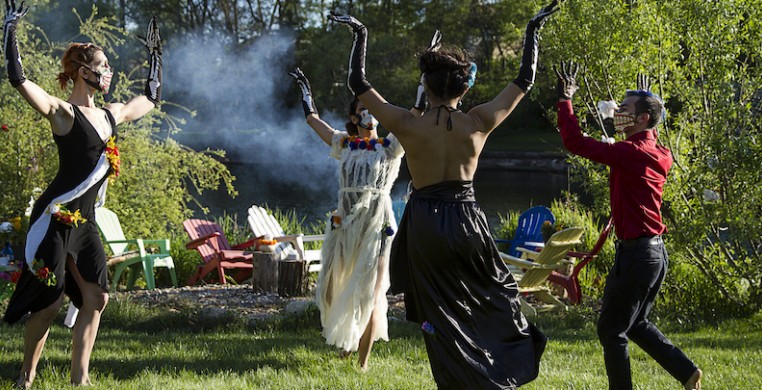Dressed in a sweet floral print vestido, Mexican American Choreographer Silvita Diaz Brown took center stage on Oct. 10 to introduce her latest dance film. An emotional Brown reminded us that this project is sacred. It holds all that is dear, and she is truly grateful that the stars have aligned for this offering to come forth. Brown, in collaboration with director Alexandra Yasivnovsky, offered us “Visita a Nuestra Muertos,” a dance film that finds us in the life/death cycle of the Fall season as we culminate Hispanic Heritage Month and begin to usher in the festive energy of “Dia de Los Muertos” (a traditional Mexican day of remembrance that pays homage to those who are no longer with us in physical form.) The project, funded by the Chicago Dancemakers Forum’s Digital Dance Grant, debuted at one of Chicago’s cultural treasures, the National Museum of Mexican Art, coinciding with the opening of the 35th Annual Dia de Los Muertos exhibit “A Time to Grieve and Remember.”
The exhibit features the work of local artists in addition to site-specific installations created by artists from both sides of the U.S. border, offering a collective atmosphere for mourning, one of the foundational characteristics of Dia de Los Muertos. We are reminded of our unified work during this time; to pay our respect to essential workers and to properly honor our ancestors, especially those who have recently transitioned. With this common thread of remembrance, both the exhibit and the film are in constant conversation with one another, weaving together floral threads of paying homage, dancing the stories of the deceased and lighting a candle to pave the path of our healing through our diverse spiritual practices.
The ofrenda dedications within both the exhibit and dance film were personal and specific. I had chills facing the massive altar at the beginning of the exhibit adorned with white candles, baskets of fruit, portraits of loved ones lost during COVID, and tamales y pan. I also resonated with the altar dedicated to Adam Toledo, a 13-year-old boy gunned down by a police officer during the pandemic. Donned with Cheetos, a Dennis Rodman jersey, yellow marigolds, Coca Cola cans and family photos, I remembered him.
Smudged sage, an ignited cigar and a bottle of vodka are the lingering spiritual imagery in the opening ofrenda scene of the dance film “Visita a Nuestra Muertos.” I consider my own spiritual practice in the Lucumi tradition and how it resembles much of what I witnessed as dancer Juan Enrique Irizarry has a moment with his ancestors at the lavish altar. As we transcend into the second scene, Brown emerges from a cloud of cigar smoke. Specifically, what I recall was the palpable energy that stretched through Diaz’ pointed feet and fingers as she connected to physical memories of her late mother. Tapping into her fountain of experience in acroyoga and lyrical dance, Brown captivated us with a solo, open-air vignette dedicated to her mother, who was the inspiration behind this project. We hear the lines, “Era muy pequeña cuando perdi a mi mama a las cinco anos, para saber lo que perdido.” My brain danced between English subtitles and wanting to translate what I could grasp from my own understanding of Spanish: a duality that Brown visits intensely in her previous dance theatre piece “Leyendas y Realidades.” Although Brown’s mother served as the initial spark behind the piece, she was not the only loved one remembered.
The remaining three dancers, Ileana Nadine Mauricio, Irizarry and Dylan Roth, were also invited to the path of healing by channeling memories of their ancestors through solo restorative movement also choreographed by Brown with guided poetry by Lani Montreal. Naturally this extended communal gesture, and along with the celebratory score assembled by Wiebe Dirk, encouraged a ripple effect for the audience to reflect on the personality and espiritu of their beloved ancestors.
Each scene was performed outdoors amid a backdrop of serene natural elements. I especially appreciated the moment when the dancers were reduced to their vertical Zoom boxes as a contrast between their unrestricted expression in nature and the restricted reality they faced due to the pandemic. In the end, the ensemble generated lovely movement together and ultimately created a life-sized balancing inverted structure which reflected the healing that was inevitably taking place. I left the premiere with amplified energia to celebrate “Dia de Los Muertos” in the coming weeks. I’ve often approached the day of remembrance as an opportunity to journey deeper into Mexican culture but after experiencing the specificity of “Visita a Nuestra Muertos” I am excited and determined to uplift the essence of my own foremothers and forefathers. For this reminder, I feel aligned and grateful.


